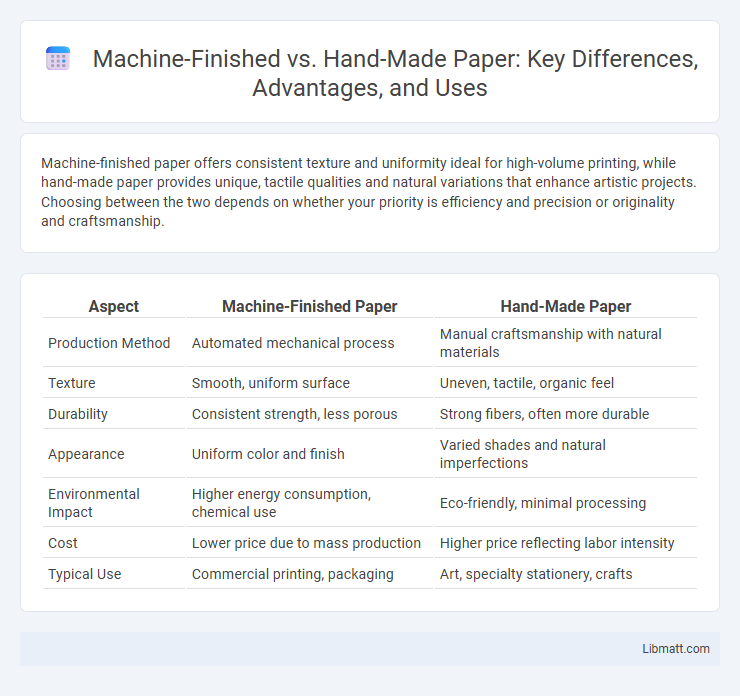Machine-finished paper offers consistent texture and uniformity ideal for high-volume printing, while hand-made paper provides unique, tactile qualities and natural variations that enhance artistic projects. Choosing between the two depends on whether your priority is efficiency and precision or originality and craftsmanship.
Table of Comparison
| Aspect | Machine-Finished Paper | Hand-Made Paper |
|---|---|---|
| Production Method | Automated mechanical process | Manual craftsmanship with natural materials |
| Texture | Smooth, uniform surface | Uneven, tactile, organic feel |
| Durability | Consistent strength, less porous | Strong fibers, often more durable |
| Appearance | Uniform color and finish | Varied shades and natural imperfections |
| Environmental Impact | Higher energy consumption, chemical use | Eco-friendly, minimal processing |
| Cost | Lower price due to mass production | Higher price reflecting labor intensity |
| Typical Use | Commercial printing, packaging | Art, specialty stationery, crafts |
Introduction to Machine-Finished and Hand-Made Paper
Machine-finished paper is produced using automated processes that ensure consistent texture, smoothness, and uniform thickness, commonly utilized in commercial printing and packaging industries. Hand-made paper involves traditional techniques where sheets are crafted manually, resulting in unique textures, natural fibers, and artisanal qualities favored for fine arts and specialty stationery. The choice between machine-finished and hand-made paper significantly impacts durability, aesthetic appeal, and production scale tailored to specific applications.
Historical Evolution of Paper-Making
Machine-finished paper emerged during the Industrial Revolution, revolutionizing the historical evolution of paper-making by introducing mechanized processes that significantly increased production speed and volume. In contrast, hand-made paper dates back to ancient times, with artisans meticulously crafting each sheet, resulting in unique textures and qualities prized for artistic and archival purposes. Understanding these origins highlights how your choice between machine-finished and hand-made paper influences durability, aesthetic appeal, and historical authenticity.
Defining Characteristics: Machine-Finished Paper
Machine-finished paper is characterized by its smooth, uniform surface achieved through mechanical calendaring processes that compress and polish the fibers consistently. This type of paper typically exhibits higher brightness, consistent thickness, and less texture compared to hand-made paper, making it ideal for printing and commercial applications. Your choice of machine-finished paper ensures reliable quality and efficiency in production, with less variability than hand-crafted alternatives.
Unique Qualities of Hand-Made Paper
Hand-made paper exhibits unique qualities such as irregular textures, natural fibers, and distinct deckle edges, which create an artisanal and authentic appearance unmatched by machine-finished paper. Your projects benefit from its enhanced durability and organic feel, ideal for fine art, stationery, and special invitations. These characteristics emphasize craftsmanship and individuality, making each sheet one-of-a-kind.
Production Processes Compared
Machine-finished paper is produced using automated rollers and large-scale machinery that ensure uniform thickness and smooth texture, resulting in faster and more cost-effective production. In contrast, hand-made paper involves manual techniques such as sheet formation from pulp, pressing, and air drying, which create unique textures and natural irregularities valued in artisanal crafts. Understanding these production processes helps you choose the right paper based on your needs for consistency or artistic quality.
Texture, Appearance, and Performance Differences
Machine-finished paper offers a smooth, uniform texture ideal for consistent printing and mass production, while hand-made paper features a unique, tactile surface with visible fibers that add character. The appearance of machine-finished paper tends to be glossy or matte with precise edges, contrasting with the irregular edges and organic look of hand-made sheets. In terms of performance, machine-finished paper excels in durability and efficiency for commercial use, whereas hand-made paper provides superior absorbency and strength, making it preferred for artistic projects and premium stationery.
Environmental Impact: Sustainability and Resources
Machine-finished paper typically requires large amounts of water, energy, and chemicals, resulting in a higher environmental footprint compared to hand-made paper. Hand-made paper often uses recycled fibers and natural materials, reducing waste and promoting sustainable resource use. Choosing hand-made paper supports eco-friendly practices by minimizing pollution and conserving natural resources.
Cost Analysis: Affordability and Value
Machine-finished paper typically offers greater affordability due to mass production efficiencies, significantly lowering costs compared to hand-made paper. Hand-made paper, while more expensive, provides unique texture and durability that can enhance the perceived value for specialized uses like art and premium stationery. Cost analysis reveals that businesses choosing machine-finished paper benefit from budget-friendly options for bulk needs, whereas hand-made paper justifies higher prices through exclusivity and craftsmanship quality.
Best Applications for Each Paper Type
Machine-finished paper excels in applications requiring high uniformity, such as printing books, mass-produced stationery, and packaging materials due to its consistent texture and strength. Hand-made paper is preferred for artistic works, premium invitations, and archival documents where unique texture, durability, and aesthetic value enhance sensory experience. Selecting the appropriate paper type depends on balancing production scale, tactile quality, and the importance of visual or historic appeal.
Choosing Between Machine-Finished and Hand-Made Paper
Choosing between machine-finished and hand-made paper depends on your project's texture and quality needs; machine-finished paper offers uniformity and smoothness ideal for bulk printing, while hand-made paper provides a unique, textured feel perfect for artistic or luxury products. Machine-finished paper is produced with automated processes ensuring consistency in thickness and finish, making it cost-effective and widely available. Hand-made paper's intricate fibers and natural irregularities yield a tactile experience that enhances invitations, special editions, or crafts where originality and craftsmanship are valued.
Machine-finished vs hand-made paper Infographic

 libmatt.com
libmatt.com